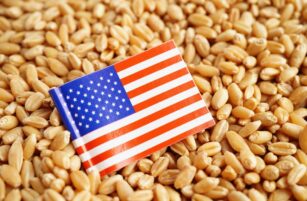Insight Focus
Grains were down again on the back of ample supply even after the USDA published lower ending stocks in the August WASDE report. There are question marks over whether selling pressure has finished or if there is still further downside risk.
Last week started with the publication of the August WASDE report, which showed a small reduction in US and world corn carry as well as in wheat stocks. But still the big picture is of ample supply and it was another negative week for all grains in all markets.
The reality is that US corn carry justifies a sub-USD 4/bushel market as we have mentioned several times and farmers need to get rid of the sizable stocks on farm ahead of the imminent new harvest. Wheat is also feeling harvest pressure. It is difficult to be bearish at current levels, but we also don’t see any reason for upside risk, so we expect the sub-USD 4/bushel market to consolidate for corn in Chicago.
There is no change to our Chicago corn forecast for the 2023/24 (September/August) crop to average USD 4.6/bushel with a downside bias toward USD 4.4/bushel. The average price since September 1 is running at USD 4.45/bushel.
Corn Bearish Despite Lower Stocks
The August WASDE reduced US corn carry for the current 23/24 crop by 10 million bushels in a combination of lower demand but higher exports.

The USDA increased its production estimate for 2024/25, reducing harvested acres by 700,000 but increasing yield to 183.1 bushels per acre compared with 181 bushels per acre in July. This all resulted in 47 million bushels of higher production.

Source: USDA
The demand figures were revised lower, with 15 million bushels of less food, seed and industrial use, and 75 million bushels of higher exports. These changes leave the 2023/24 stock-to-use ratio unchanged at 12.6% and that of 2024/25 is reduced from 14.1% to 13.9% — not really material to the market.
World ending stocks fell for the 2023/24 crop by an immaterial 610,000 tonnes. while 2024/25 ending stocks saw a 1.47 million tonne reduction all coming from less production. Russia was down to 14.1 million tonnes compared with 15 million tonnes before. Ukraine was down by 500,000 tonnes and the EU by a sizable 3.5 million tonnes.

Source: USDA
Conab in Brazil reduced its corn forecast to 115.6 million tonnes or -0.2% on its previous forecast. This compared with the August WASDE projections of 122 million tonnes.
The US corn condition was 67% good or excellent, flat week on week and up from 59% last year. The area under drought condition was 6%, or one-point higher week on week. The French corn condition was 76% good or excellent, down one point over the week. Argentinian corn is 97.8% harvested, while the Brazilian Safrinha corn (second crop) is 94.7% harvested – well ahead of the 72.4% recorded at this time last year.
Lower Carry Can’t Support Wheat
On the wheat side, the WASDE report revised the US carry for the 2024/25 crop lower by 28 million bushels, all coming from 26 million bushels of lower production and 2 million bushels of higher demand.
Global ending stock were reduced by a marginal 620,000 tonnes. Besides the lower US production, Australia was revised 1 million tonnes higher, the EU 2 million tonnes lower, and Ukraine 2.1 million tonnes higher.

Source: USDA
US winter wheat is 93% harvested, about level with 91% last year and the five-year average of 91%. Spring wheat is 18% harvested, just behind 20% last year and the 21% five-year average, with condition 72% good or excellent, down two points week-on-week.
The area under drought conditions worsened again to 43% for winter wheat compared with 40% the previous week, but with winter wheat almost fully harvested these worsening conditions should have no impact at all.
Russian wheat is 56% harvested with an average yield of 3.5 tonnes per hectare — or 14% lower year on year. Ukrainian wheat is now fully harvested with yields 3% lower year on year. French wheat condition is 47% good or excellent, down one point week on week and versus 76% last year. The crop is 98% harvested, just ahead of 95% last year and the 95% five-year average.
In Germany the DRV association reduced its wheat production forecast to 18.78 million tonnes or down 12.8% year-on-year on the back of lower area and lower yields.

Big Picture Emerges
Warmer temperatures and dry weather are expected in Brazil, with the only exception of the south. Northern Europe is expected to continue experiencing hot temperatures but ample rains, while very hot temperatures are expected to remain in the east. The US is forecasted for hot temperatures, but rains should continue.
Despite the reduction of ending stocks published by the WASDE and the lower corn production published by Conab in Brazil, the big picture is that global supply is ample, and the market appears to have priced in the lower wheat supply in France and Germany and the deterioration of corn in Eastern Europe.













